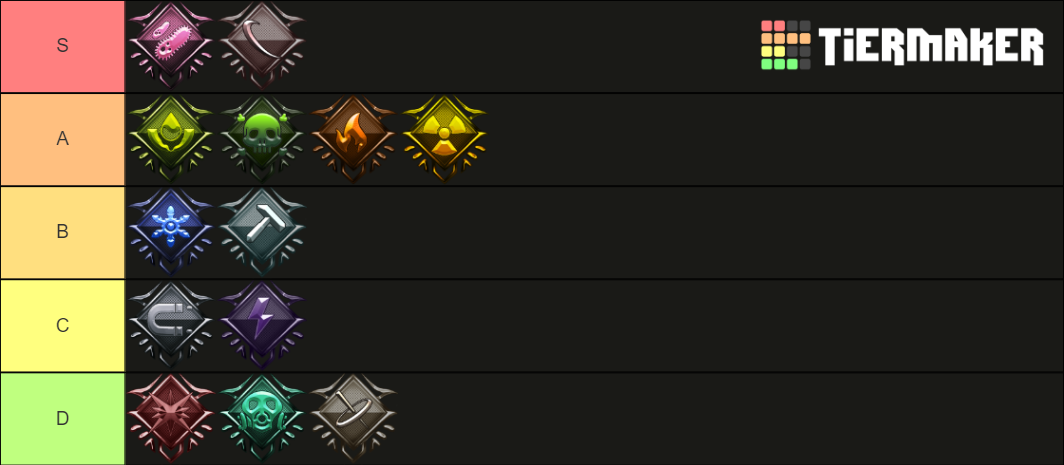Based on a combination of factors including:
- Applicability of the type against different factions
- Quality of the debuff the damage type applies
- Other unique bonus features of the types
This is my personal opinions and experiences with the different damage types in Warframe, and which ones you’d want to slot your weapons up to utilize.
The overall tier list

Top Tier: Viral, Slashing
Excellent Tier: Heat, Radiation, Corrosive, Toxin
Good Tier: Cold, Impact
Situational Tier: Electricity, Magnetic
Bad Tier: Gas, Blast, Puncture
Physical Damage Types
Instead the qualities of physical damage can be considered on the base weapon to make decisions about what elemental effects might synergize best with it.

Increased Damage On:
- Cloned Flesh (Grineer)
- Flesh (Corpus Crewmen and other humans)
- All health types associated with Infested enemies (except Sinew, found on Cambrion Drift enemies)
- Infested Flesh takes extremely high bonus damage (infested corpus crewmembers)
Decreased Damage On:
- Ferrite Armor (Mainly Grineer, but fairly commonly spread out among all enemy types that have armor)
- Alloy Armor (Used by Elite Grineer units and Corpus Robots – Highly Ineffective!!)
- Robotic Health (Unarmored health on robots found below the armor)
Overall Performance against factions:
- Grineer – Strong
- Corpus – Moderate
- Infested – Very strong
Slash is a common and highly-effective damage type by my measures – in addition to being on a bunch of melee weapons, most of its drawbacks are quickly canceled out by the traits of its status effect, as the Bleeding it inflicts can heavily damage enemies that theoretically would be resistant to it (mainly Grineer). It’s precisely because of how its bleed works that makes it a staple for easily dealing damage on the Steel Path, where the armor effects of enemies is multiplied heavily – bleed can entirely bypass this. Weapons that specialize in both Status Chance and Slashing type are real keepers.
Slash can also be a good option if you have the ability to strip armor off of your targets (either by using Corrosive damage, or with special Warframe abilities) – once armors are removed, only one type of health (robotic) has a resistance against the type. Otherwise, biological targets quickly get ripped to shreds by this damage type.
Even with all its bonuses, Slash falls a bit short against the Corpus, due to a combination of its bleed having to get through their shields first, and their variety of robots having no weakness to the type at all. Even so, the effectiveness of its status effect keeps it well relevant in most situations regardless.

Increased Damage On:
- Machinery (Exclusively Grineer Robots)
- Shields and Proto-Shields
- Proto-Shields are used by essentially all non-corpus factions when a shield is involved.
- Shields, ironically, are much weaker to impact than proto-shields are!
- Infested Flesh takes extremely high bonus damage (infested corpus crewmembers)
Decreased Damage On:
- Flesh and Cloned Flesh (Grineer and Corpus humanoids only – Infested are exempt from this and will still take full damage from impact.)
Overall Performance against factions:
- Grineer – Mediocre
- Corpus – Strong
- Infested – OK
Impact, between all the different weapons and abilities you can use, is probably the most common damage type of them all, so it’s kind of impossible to avoid it. That said, it benefits from not being particularly bad against any types of armor or protection, while also being spectacular at damaging shields. Even with its reduced damage to flesh, it also isn’t resisted heavily by armor, so its damage output can sometimes be better on a heavily-armored fleshy target than if you were to attempt slashing on them.
Impact’s debuff effect is decent, and can be used for some good soft crowd-control, by denying enemies opportunities to attack. It’s nothing really outstanding, however. What is neat about Impact is that it has several mods you can use to impart its effects with chances to apply better status effects, such as Internal Bleeding.
Impact is common and generally well-rounded, but it’s not usually going to be something you’d want to (or need to) maximize. It helps to keep most weapons even-keel in terms of their performance against all target types, and of course is not at all a bad thing to have when shields are involved.

Increased Damage On:
- Ferrite and Alloy Armors (if you see something that has a yellow health bar? This can be effective.)
- Comparatively, much more effective on Ferrite Armor than Alloy, so expect it to work a lot better against lighter-weight Grineer targets.
- Robotic Health (effective on Corpus robots after their armor has been removed.)
- Infested Sinew (Cambrion Drift’s giant infested)
Decreased Damage On:
- Shields and Proto-Shields (with Proto-Shields being much more resistant!)
Overall Performance against factions:
- Grineer – Meh
- Corpus – Not OK
- Infested – OK
A damage type that’s commonly found on weapons made to be “strong” against armor, in most cases where you’d want to be using it against a heavily-armored target they’re usually wearing Alloy Armor, which just happens to be the damage type that Puncture offers the lowest benefit against (+15%). Put up against your typical Elite Grineer Lancer on the Steel Path (who invests heavily in both Alloy Armor and Damage Reduction), this damage type falls waaaay short of its intended purpose.
The debuff effect could seem useful if you really need extra survivability, but in many cases most Warframes have more reliable mechanics they can use to bolster their own survivability (with some like Nezha, Gara, and Gauss being capable of reducing incoming damage by up to 90% with just one ability usage, versus the 75% you have to build up and maintain with Puncture Statuses). By the time you’ve built up 10 stacks of a status effect, though, you’d probably want your target dead, not just incapacitated or 25% as damaging as before.
The damage type is theoretically also good against Corpus robots and Infested targets, but weak against shields, and virtually every Corpus Robot has a shield in addition to their health and armor, so it’s kind of a moot point when the Puncture damage type is explicitly terrible against shields. In the case of Infested who don’t inherently have any kind of puncture resistances – honestly, min-maxing the damage type against them is a complete non-issue.
Pure elemental types
Using pure damage types, while useful, also is a sacrifice and challenge, as using multiple elemental mods will tend to make them combine. Read across a row from left-to-right, each subsequent elemental mod will combine with the previous one in the sequence. An example will be explained in the combined-element section.

SPECIAL NOTE – Heat is the only status effect where applying the status will refresh the duration of all stacks. This means that stacks of Heat don’t gradually decrease over time between attacks, but instead will drop off suddenly after around 6 seconds. If you’re constantly applying Heat status, however, then it’s extremely easy to keep this value at the full 10 stacks.
Increased Damage On:
- Cloned Flesh
- Infested and Infested Flesh (very effective against the latter!)
Decreased Damage On:
- Proto-Shields
Overall Performance against factions:
- Grineer – Very effective
- Corpus – Good
- Infested – Extremely effective
If there’s one pure elemental type you’d want on your build, this would be it – a type that almost nothing is strong against, and combines soft crowd-control with defense reduction AND damage over time? Heat can basically be seen as the “jack-of-all-trades” status effect and type. There’s no situation where it isn’t welcome or effective, and its unique traits make it easy to keep its benefits active with.
While it’s a jack-of-all-trades, this also means it’s a master of none. 50% extra damage still won’t be that much in the greater scope of things when high amounts of armor are involved. Heat is probably overall the 2nd priority for a damage type you’ll want after Viral (and it conveniently can be fit in alongside Viral’s type combination of Cold/Toxin), and you’ll likely want to use it in a context like this, because its lone benefits can only really go so far.

SPECIAL NOTE – in relation to the above debuff as well as just inherent to Toxic damage itself, it completely bypasses and ignores shields, making it something of the inverse of Slash and bleed.
Increased Damage On:
- Flesh (It’s very strong against generic flesh. But this is the only damage type it’s strong against. It’s neutral against most other unarmored health types.)
Decreased Damage On:
- Machinery (Grineer)
- Robotic (Corpus bots)
- Fossilized (Infested health on large creatures and ancients – way less effective here.)
Overall Performance against factions:
- Grineer – Average
- Corpus – Good!
- Infested – Poor
For any situations where you’re up against targets with augmented shields, particularly Sorties, this is going to be your go-to type, as its unique ability to bypass all shielding means that it can very quickly take-down targets that otherwise would be impregnable against their shielding. Similar to Impact, it’s a damage type that isn’t that widely resisted, but at the same time doesn’t have that many weaknesses it can exploit aside from the mechanical one above. The inherent traits of its damage type means that it’s one of the few types that can absolutely flourish when it’s placed on a critical-based weapon, as opposed to emphasizing statuses purely.
Even with most robotics resisting its damage type, the resistance isn’t so huge to be prohibitive, and the effect of its status can insure it remains fairly harmful to these machines. Because almost every single Corpus robot comes with a shield, its applicability to inflict some starting damage to them while their shield is up means it can remain useful, but arguably using strong physical damage and corrosives would prove more effective.
Toxic is quite effective, but difficult to set up for, as its a component for some extremely-effective compound damage types! This can make fitting a toxic effect into your weapon’s build a challenge unless the weapon you’re using just inherently has toxic damage as a part of it.

Increased Damage On:
- Alloy Armor
- Shields (very effective! Same efficacy as using Impact damage)
- Infested Sinew
Decreased Damage On:
- Infested Flesh (strong resistance)
- Fossilized Health
Overall Performance against factions:
- Grineer – Fair
- Corpus – Extremely Effective
- Infested – Bad
A useful crowd-control type with good applicability against the most problematic factions, Cold is quite good at what it does, and might be the absolute answer to what you’d want to bring in a fight against the Corpus if shields are proving to really be a problem (and you wanted to break the shield down rather than just toxin-ing your way past it).
It’s very easy to combine this type with Impact to make for the ultimate Corpus-Bot crushing weapon, but it otherwise won’t be seen that often. As stated above, it’s usually a component in formulating the dreaded Viral damage type.

Increased Damage On:
- Machinery (Grineer)
- Robotics (Corpus)
- Both of these take heavy extra damage from Electricity.
Decreased Damage On:
- Alloy Armor (Many heavy-duty armored targets… and it’s a heavy resistance).
Overall Performance against factions:
- Grineer – Poor
- Corpus – Fair
- Infested – OK/Maybe good?
Electricity’s proposal as an anti-robot tool is seriously hampered by its absolute ineffectiveness against Alloy Armor, which most robots use. In fact, Alloy Armor’s the armor type that most actually difficult enemies use, so the usefulness of Electricity in high-level play is extremely bad! This is paired with a debuff effect that, while it offers some crowd-control benefits somewhat identical to that of Fire with its stun animation, also manages to fall short in its task for dealing AoE damage (a theme we’ll see later with Gas).
Its capacity to stun combined with effectiveness in bunched-together enemy formations, and the fact that the faction overall has no resistances to the type, means that it ironically might be best suited to fighting Infested – that’s damning because it’s also not even the best type for that purpose.
Electricity is, as a result, mercifully used for formulating the much better Radiation and Corrosive effects. Outside of situations where armor is involved, Electricity is otherwise ok at its job for doing damage.
Combined Damage Types (The Good Stuff)
The slots are applied in an order of priority, read left-to-right across your mod rows.
 In this example, we have Heat and Electricity in slots 1 and 2, and Cold and Toxin in slots 3 and 5 (on the next row). Starting from the top-left, heat is applied. In the second slot, electricity is found and will then combine with the existing heat to form Radiation. The next mod found is a Toxic mod, which then goes on to combine with the Cold damage mod on the next row in slot 5, creating Viral. Any extra damage mods would just combine with the existing damage types.
In this example, we have Heat and Electricity in slots 1 and 2, and Cold and Toxin in slots 3 and 5 (on the next row). Starting from the top-left, heat is applied. In the second slot, electricity is found and will then combine with the existing heat to form Radiation. The next mod found is a Toxic mod, which then goes on to combine with the Cold damage mod on the next row in slot 5, creating Viral. Any extra damage mods would just combine with the existing damage types.
 If you wanted to have a pure damage type on top of a combined one, ensure that the element you want the pure type of is the last in the list.
If you wanted to have a pure damage type on top of a combined one, ensure that the element you want the pure type of is the last in the list.

Debuff Effect – Infects enemy’s health, amplifying damage dealt to a target’s health by up to 325%(!!?!?) when stacked. This is more effective against Armored targets than Shielded ones – armored targets take reduced health damage, whereas shielded ones won’t take that health damage until the shield’s been disabled (or the shield’s bypassed….!)
Increased Damage On:
- Cloned Flesh
- This is probably one of the most extreme weaknesses in the game, with Grineer humanoids taking an extra 75% damage from this type.
- Flesh (take 50% extra damage here, so our non-inbred friends aren’t by any means safe from this either!)
Decreased Damage On:
- Machinery (but not robotic for some inscrutable reason)
- Infested
Overall Performance against factions:
- Grineer – INSANELY GOOD.
- Corpus – Extremely good.
- Infested – Good or Bad, depending on what you’re up against…
This is the god-tier damage type in the game right now. I guarantee you, if you set up a weapon to do Viral Damage, you will find success against basically 90% of the enemies in the game. Everything has health, so a status effect that straight-up triples the amount of damage you deal to that health renders any kind of other (non-shield) mitigation mechanics null and void once that’s been put into place.
This said, Viral’s not the be-all end-all damage type, as there’s several cases where enemies will actively resist the Viral status effect (the main selling point of this type):
- A large number of Cambrion Drift infested resist the status. (Note that most normal infested don’t have this benefit, so even though they don’t have an explicit weakness to the type, they still get utterly destroyed in most situations by it still!)
- The Ambulas Corpus Robot resists this type.
- Demolisher-class Infested in Disruption missions, in a couple of cases, are entirely immune to viral damage. This makes the Saturn Disruption mission perhaps the one place where you’re probably not safe bringing in a Viral weapon.
In cases where shields are layered on heavily to targets, having just pure Viral also usually won’t do the trick – theoretically you could get past this if you managed to have a way to apply Viral followed by Toxin, but given that Toxin is a component in creating Viral in the first place, you’d need to either find a very specific weapon for this setup, or switch between two weapons to pull this trick off on Corpus foes.

Debuff Effect – Radiated enemies are confused, and will try and hit random targets with their weapons. If they hit their allies, they also will deal double-damage (base), which then increases for each additional stack until they’re dealing 550% extra damage (!?) to their allies.
Increased Damage On:
- Alloy Armor (this is a BIG one – both literally at 75% and meta-wise with what kind of targets are using this armor.)
- Robotic
- Infested Sinew
Decreased Damage On:
- Shields (but not Proto-Shields)
- Infested
- Fossilized
Overall Performance against factions:
- Grineer – Great
- Corpus – Excellent
- Infested – Mediocre
Radiation has a spectacular and silly debuff, but that isn’t even the main standout benefit of using this type. Instead, its extreme strength against Alloy Armor means that it is the damage type you’ll be using the most against some of the heaviest-hitting bosses and enemies in the game – the Eidolons and Profit-Taker being the big ones that are most heavily hit by this type. And because these huge targets are usually immune to statuses (including a specific status that normally would be ramping up damage taken by 325%…) it’s this type we go to in order to lay in heavily on our big bosses.
The combination of traits it has also makes it extremely effective against powerful Corpus robots, and even leaves room for you to put in Cold damage to counteract their shields!
A strong damage type combined with a status that can (in spite of enemies who might be resistant to the type) sow chaos and infighting among enemies – this makes it an excellent damage type for fighting major bosses and for hit-and-run distraction.

Debuff Effect – Corrodes armor, reducing the target’s armor effectiveness by up to 80%, and can go even further if you combine this with the effects of Fire.
Increased Damage On:
- Ferrite Armor (very strong 75% bonus on this one!)
- Fossilized (Also a 75% bonus)
Decreased Damage On:
- Proto Shield (50% penalty)
Overall Performance against factions:
- Grineer – Good
- Corpus – Good
- Infested – Good-ish
A solid damage type for dealing with armored foes, Its status effect is combined with a good damage profile that very few targets can resist. It can serve a strong alternative to Viral in situations where its effects aren’t pertinent.
While still fully effective against Infested, I mark down ‘good-ish’ here because almost no enemy on this faction even uses armor, so the benefit its status provides is basically a moot point. Overall, if something has a yellow health bar (indicating the presence of armor) – corrosive will work quite well.
Combined Damage Types (The Bad Stuff)

Debuff Effect – Disrupts targets, causing the targets’ shields to take up to 325% bonus damage, and prevents the targets shields from recharging.
Increased Damage On:
- Shields and Proto Shields (+75%!)
Decreased Damage On:
- Alloy Armor (-50%…)
Overall Performance against factions:
- Grineer – Bad
- Corpus – Effective!
- Infested – Whatever
A damage type with a situational debuff, combined with a damage resistance against one of the most drastic armor types in the game? It’s pretty clear to see how and why this damage type can fall short. Magnetic damage is made to do one thing only, and that’s to destroy shields… But keep in mind we already have two other damage types that are also effective against shields (one of which is consumed to make this thing) and that shields also don’t inherently benefit from being layered with their own sets of armor like health is – basically the benefit of having a Viral effect for shields is entirely moot when you consider that such a slim percentage of the enemy roster even uses them.
Against the Corpus, this can absoultely wreck house against their forces, but outside of this, you probably wouldn’t want to be caught dead with a magnetic weapon.

Debuff Effect – Blast inflicts inaccuracy (for some reason) which causes targets aim to falter and get reduced by up to 75%
Increased Damage On:
- Grineer Machinery
- Fossilized Infested Health
Decreased Damage On:
- Ferrite Armor
- Infested Sinew
Overall Performance against factions:
- Grineer – Meh
- Corpus – OK
- Infested – Bad-ish.
Weird and questionably useful debuff, combined with unimpressive damage bonuses. In some cases, such as infested, the debuff isn’t even useful because aiming isn’t exactly a factor when you’re in melee range.
By the numbers, its effects and resistances make it the ‘best’ against the Corpus – they heavily use ranged weapons and don’t have any kind of resistance to the type, so blasting them is sure to be as effective as you’d expect it. That said? Still not much going for it. It’s mainly a neutral interaction.
Similar to Puncture, this is a “defensive” debuff, but unlike Puncture it’s not guaranteed damage-reduction, and it isn’t even that effective against good or common health types. It’s one saving “grace?” is that there’s a variety of effective ranged weapons that just inherently use Blast, and they aren’t that much worse for it. However, when you have the choice with mods, avoid building anything deliberately for blast. Both Heat and Cold can be used for much, much better things.

Debuff Effect – Gas creates clouds, which will proceed to damage surrounding targets with further Gas damage. As you stack it up, it can grow to be a radius of 6 meters.
Unlike every other DoT status effect, this one does not scale with the base elemental damage of the weapon or effect that dealt the status. This means it does dramatically less damage than any other DoT, even when considering that the different gas clouds from bunched up enemies can all stack and overlap.
Increased Damage On:
- Infested
- Infested Flesh (yes these are apparently different things.)
Decreased Damage On:
- Cloned Flesh (-75%)
- Flesh (-50%)
Overall Performance against factions:
- Grineer – Bad
- Corpus – Bad
- Infested – Serviceable
Gas is the perfect solution to an enemy group that wasn’t even a problem to begin with, and much like with Magnetic, has much simpler alternatives that basically work just as well (in this case, just using pure Heat is basically as effective and induces more crowd-control with the stun), and similarly suffers from its hyper-focus by being basically useless against anything else.
To make matters worse, its status, and its damage traits, means that it also doesn’t perform particularly strongly against the biggest infested monsters either, and having one gas cloud hovering around a single, meaty target isn’t going to do you much good if it’s not taking at least 1% of its health per second you spend shooting it.
If you really wanted to make an anti-infested weapon, you’d likely be better just defaulting to the normal viral/fire combination – weak infested remain vulnerable to the viral effect and so will die that much faster, while those that theoretically would be immune to viral still get affected by your fire portion anyways.

